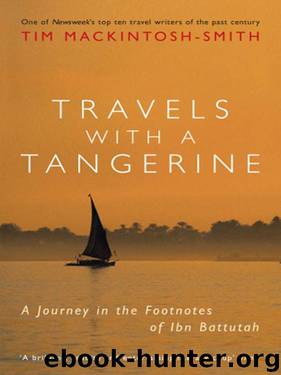Travels with a Tangerine: A Journey in the Footnotes of Ibn Battutah by Tim Mackintosh-Smith

Author:Tim Mackintosh-Smith [Mackintosh-Smith, Tim]
Language: eng
Format: epub, mobi, azw3
ISBN: 9781848546769
Publisher: John Murray
Published: 2012-03-15T06:00:00+00:00
A miniature from the fifteenth-century Livre des merveilles shows the fantasy version of Masyaf, a turreted enclosure set among tusk-shaped mountains. Outside, human-headed deer prance or flop on the grass and a simpering harpy flaps through the air. Within the walls gormless-looking youths and damsels dance before an elderly king. The king has just raised his finger to point at the nearest youth; the dancers stare at him, frozen in mid-movement.
The picture, one of the most vivid images of the Orient in the post-crusading mind, illustrated a pervasive legend: the Old Man lured innocent youths, doped them out of their minds on hashish (hence hashshashin and ‘Assassins’), and gave them a taste of paradise with the girls in his secret garden. Every so often he would pick one or more of the young men to go into the outside world and assassinate an enemy. The killers couldn’t lose: if they got away, they would be readmitted to the garden; if they were killed they would take the short cut to heaven. Within the Old Man’s perverted hortus conclusus are all the elements of the stereotypical cult – a megalomaniac leader, seduction and brainwashing of the young, membership of the elect, paradise guaranteed. As with a Hollywood script, successive writers gave a tweak to the more filmic features or, if they didn’t exist, made them up. The biggest name in the credits is that of Marco Polo.
The reality, like the beige walls of Masyaf, was less highly coloured. Drugs and orgies were probably no more a feature of Nizari life than were-deer and harpies. Admittedly, the Nizaris were a missionary organization, with various stages of initiation into esoteric knowledge and with total obedience to their leader. They occupied mountain fastnesses which, if not paradises, were well provisioned – in the other main Nizari region south of the Caspian, one of their castles survived a Mongol siege for fourteen years. And, being a temporal as well as a spiritual power, they naturally disposed of opponents. Like the umbrella-wielding Bulgarian secret service in the 1970s, they just did it more neatly and publicly than anyone else.
The assassinations were not always successful. One of the more celebrated failures was the attempt on the future King Edward I of England, at Acre in 1272. With him was his favourite writer of romances, Rustichello of Pisa – who, as fate had it, landed up a quarter of a century later in a Genoese gaol with Marco Polo. It would be a fair guess to assume that Rustichello’s memories of Acre, mixed with Polo’s garbled second-hand knowledge of other north Persian sects who undoubtedly did use hashish, produced the farrago of the full-blown Assassin legend. The story assured the two Italians of a goggling readership.
At the time IB was travelling, the Nizaris had long ceased to be a political power. Sultan al-Nasir, however, used them occasionally as contract killers; one of his targets was Qarasunqur, a Mamluk cold-war defector to the Mongols. ‘Al-Nasir sent suicide killers against him time after time,’ IB wrote.
Download
Travels with a Tangerine: A Journey in the Footnotes of Ibn Battutah by Tim Mackintosh-Smith.mobi
Travels with a Tangerine: A Journey in the Footnotes of Ibn Battutah by Tim Mackintosh-Smith.azw3
This site does not store any files on its server. We only index and link to content provided by other sites. Please contact the content providers to delete copyright contents if any and email us, we'll remove relevant links or contents immediately.
Autoboyography by Christina Lauren(4693)
Asking the Right Questions: A Guide to Critical Thinking by M. Neil Browne & Stuart M. Keeley(4628)
Dialogue by Robert McKee(3612)
Eat That Frog! by Brian Tracy(3552)
Sticky Fingers by Joe Hagan(3467)
Journeys Out of the Body by Robert Monroe(3017)
Elements of Style 2017 by Richard De A'Morelli(2953)
Annapurna by Maurice Herzog(2862)
Schaum's Quick Guide to Writing Great Short Stories by Margaret Lucke(2820)
Full Circle by Michael Palin(2795)
The Diviners by Libba Bray(2459)
The Art of Dramatic Writing: Its Basis in the Creative Interpretation of Human Motives by Egri Lajos(2429)
The Mental Game of Writing: How to Overcome Obstacles, Stay Creative and Productive, and Free Your Mind for Success by James Scott Bell(2404)
Why I Write by George Orwell(2378)
Atlas Obscura by Joshua Foer(2359)
In Patagonia by Bruce Chatwin(2288)
The Fight by Norman Mailer(2170)
The Elements of Style by William Strunk and E. B. White(2081)
Venice by Jan Morris(2063)
